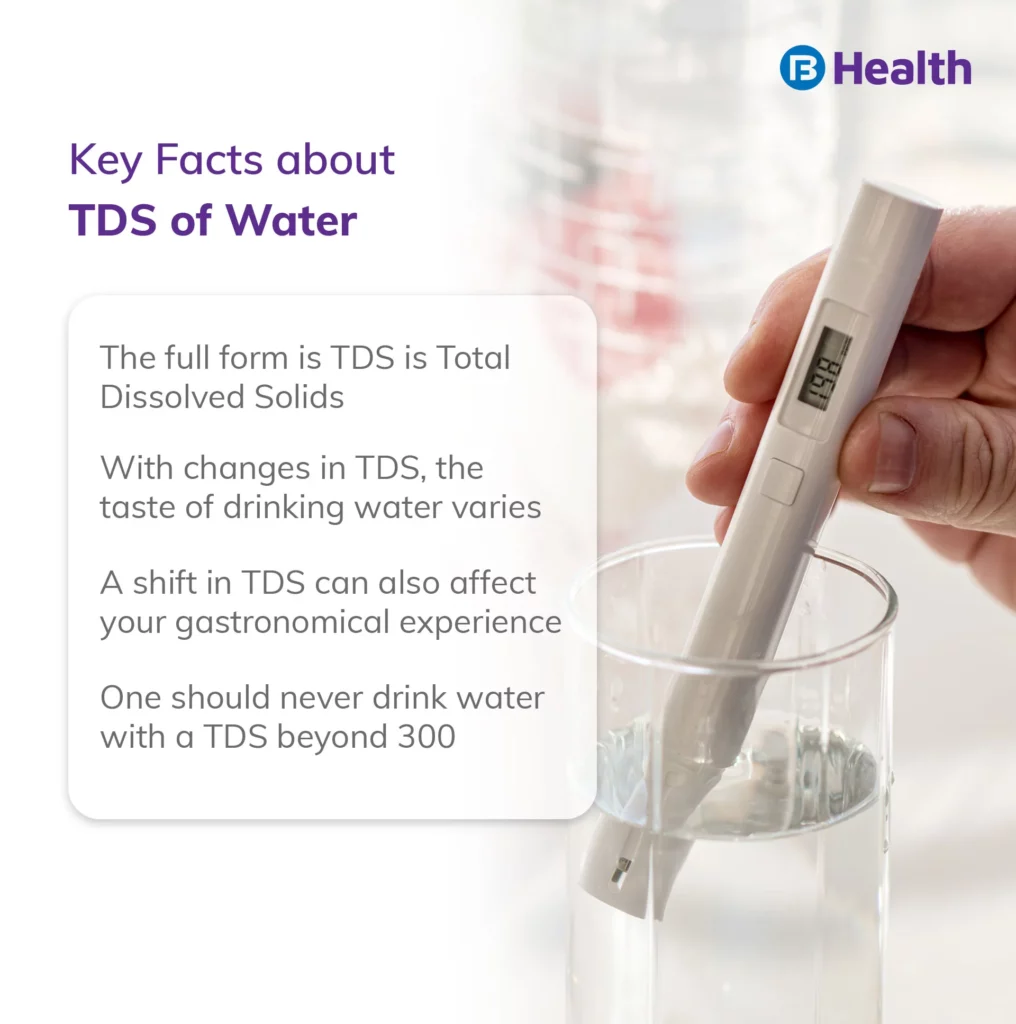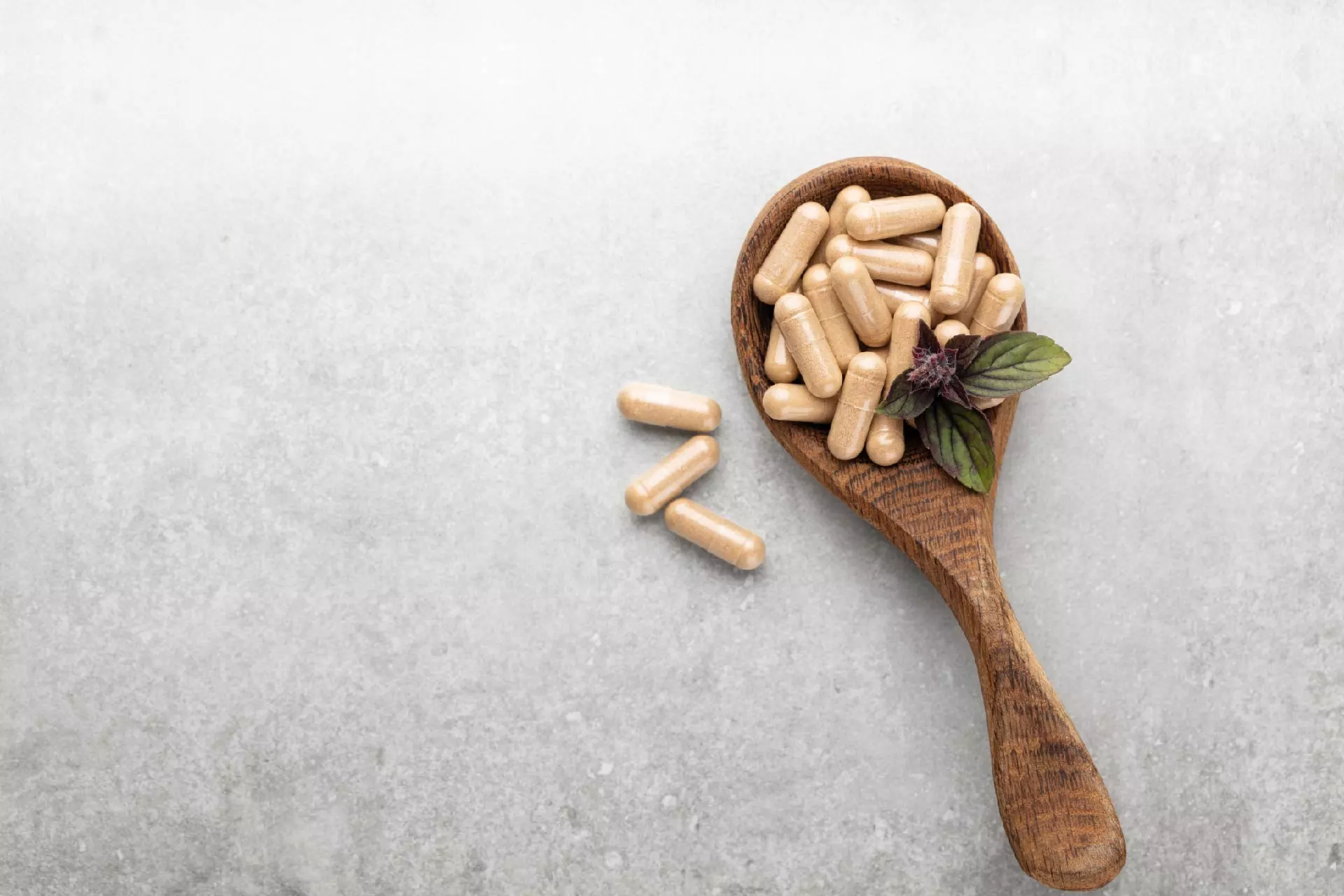General Health | 6 min read
What is TDS in Water & Why Should You Measure It?
Medically reviewed by
Table of Content
Synopsis
TDS is a key parameter to identify whether the water you are drinking or storing for domestic use qualifies the safety benchmark. This blog explains the concept of TDS and its key aspects in detail.
Key Takeaways
- TDS reflects how much solid substances have dissolved into the water
- Water with a TDS between 50-100 PPM is best for drinking
- If the TDS of water is more than 1200 PPM, it is considered unacceptable
What is the meaning of TDS? Have you ever read the term on the labels of packaged drinking water and wondered what TDS means? First, note that it is an abbreviation for ‘total dissolved solids, and it stands for the number of salts, minerals, and other compounds that get mixed into the water from different surfaces. So TDS of water is a measurement to understand how much minerals and other solid compounds have dissolved into the water. It also helps understand whether the water is healthy enough for drinking.
Measuring TDS levels in water are important because the regular drinking water we use may be highly contaminated with hazardous substances. In addition, it is common for the water we get from different water treatment plants. Read on to learn further about the TDS of water as this blog discusses the TDS of normal water, the minimum TDS for drinking water, and more.
What is TDS?
It is the measurement of all organic and inorganic substances dissolved in water. With the TDS level of water, you can understand whether the water is too mineralized or not. However, the TDS of water doesn’t reveal what exact minerals are present in the water. The usual unit of measuring TDS in water is milligrams per liter (mg/l), and it represents the mass of solid minerals dissolved in one liter of water. It is also measured in parts per million (PPM). These minerals play a key role in the taste and flavor of drinking water.

Why Is Maintaining The TDS Level Of Water Important?
Water with a high TDS may be harmful to drink. If the TDS level is abnormally high, it is not wise to use it for bathing and other domestic purposes. These are the reasons why it is important to maintain a normal TDS in water. Here are the factors that can be affected by a high TDS of water:
Taste
High TDS may lead to a salty, bitter, or metallic taste or odor.
Gastronomical experience
It has been observed that low-TDS water goes better with light foods. However, if you are consuming heavy and filling foods, you can have a glass of carbonated water with salt (high in TDS) for better digestion.
Health and nutrition
Among the minerals present in usual water, there are a few hazardous ones like copper and lead. However, moderate intake of other minerals is highly recommended health-wise. For example, calcium and magnesium can make up for your nutritional deficiency.
Domestic use
High levels of minerals like magnesium and calcium can turn water into hard water, which may accumulate these substances in the domestic pipeline. It leads to a blockage in the water supply that affects toilets, faucets, tubs, sinks, pools, and taps. Apart from this, the presence of iron in water beyond the level of 0.3 mg/l may cause stains in your laundry and other plumbing installations.
Additional Read: Health Benefits of Drinking WaterMinimum TDS For Drinking Water And Other TDS Levels To Consider
It indicates whether the water is suitable for drinking or if you need to filter it first. In addition, if the water contains some hazardous chemicals, TDS levels can help you understand whether to use it for non-drinking purposes or discard it altogether. Take a look at this TDS level chart for a better understanding.
TDS levels measured in PPM | Usability |
Between 50-100 | Best for drinking |
150-250 | Good |
250-300 | Satisfactory |
300-500 | Poor |
| More than 1200 | Unacceptable |
How To Measure The TDS Level Of Water At Home
Measuring the TDS of water at home can be possible with a handheld TDS meter. Note that a TDS meter may also determine the conductivity of water, which signifies how good a carrier of electricity the water is. Remember, pure water has zero conductivity, so its TDS is also zero. The conductivity of water increases when minerals get dissolved in the water, and the TDS of water increases too. At a standard 25°C temperature, the conductivity of water becomes equivalent to its TDS in the unit of milligrams per liter[1].
How To Reduce TDS In Water
In order to lower the existing TDS of water, you can opt for the following procedures.
Reverse osmosis (RO)
The water is kept at high pressure and passed through a synthetic membrane during this process. In the membrane, microscopic pores will let only molecules smaller than 0.0001 microns enter. As a result, minerals and salts dissolved in the water get filtered since their molecules are much larger than the permissible limit.
Deionisation (DI)
Here, a positive and a negative electrode is used through which the water is passed. It separates the ionised minerals from the water and gives you de-ionised and pure water. However, for 100% purity, make sure to run the water first through the RO process, which filters the non-mineral components.
Distillation
Here, the water is transformed into water vapor with the help of boiling and again brought back to its liquid form by cooling the vapor. This process separates the dissolved salts from water as they are not vaporized.
Most Common Types Of Minerals Found In Water
A number of minerals are found in water and contribute to its TDS. They are responsible for around 90% of TDS in water. They include zinc, iron, silica, nitrates, sulphates chlorine, bicarbonate, potassium, sodium, magnesium and calcium. Apart from these, water may also contain the following trace elements in small amounts - nitrites, arsenic, fluorides, lead, mercury, bromide, and copper.
Additional Read: World ORS Day
How Do Minerals Get Into The Water?
The water we use for drinking and other regular works is usually sourced from rainwater and other sources like ground, springs, lakes and rivers. All these types of water collect different types of salts and minerals as they flow through the natural setting of rocks and clay. Being regarded as ‘the universal solvent’, water dissolves most of the major minerals found in nature.
Apart from the minerals that get into the water naturally, water also absorbs certain hazardous chemicals due to human activity. These include agricultural and industrial waste, which are dangerous for domestic usage as well as aquatic life.
How is TDS Different From Hardness?
Though both may appear similar to many, it is important to understand that TDS and hardness are two different things. While TDS is determined by the presence of minerals and salts in water, hardness is defined by the amount of magnesium and calcium and how the water reacts with soap. As a result, water with a high TDS may not be hard. But, on the other hand, hard water doesn’t necessarily show a high value of TDS.
Conclusion
Now that you know all the major facts and other information regarding the TDS of water, you can safely use water for any purpose. If you want to know further about the average TDS of drinking water, you can book an online or offline consultation with a registered doctor on Bajaj Finserv Health. Get answers to all your health concerns in time to lead a happy and healthy life!
References
- https://iopscience.iop.org/article/10.1088/1755-1315/118/1/012019/meta
Disclaimer
Please note that this article is solely meant for informational purposes and Bajaj Finserv Health Limited (“BFHL”) does not shoulder any responsibility of the views/advice/information expressed/given by the writer/reviewer/originator. This article should not be considered as a substitute for any medical advice, diagnosis or treatment. Always consult with your trusted physician/qualified healthcare professional to evaluate your medical condition. The above article has been reviewed by a qualified doctor and BFHL is not responsible for any damages for any information or services provided by any third party.





